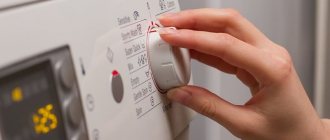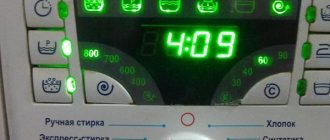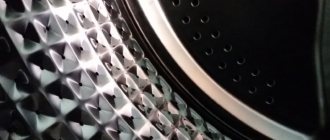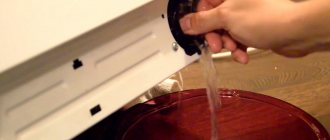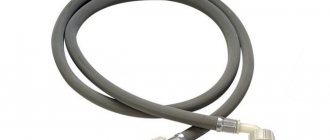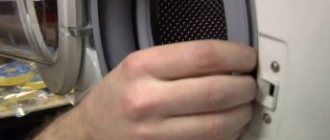A washing machine is a complex piece of equipment with many moving parts. Therefore, it makes noise and crackles during operation. But sometimes you can hear an irregular and strong cracking sound, and notice that the washing machine is sparking inside the body.
Attention! If you find sparks or a glow in the washing machine during washing or spinning, immediately turn off and disconnect the equipment. It is dangerous to operate it!
Sparking is a sign of a malfunction in the SMA. You can notice it in different places.
- Most often, sparks appear during washing or spinning below the drum in the back of the washer, where the motor is located, and are accompanied by a louder than usual crackling noise. If the equipment is in the bathroom, then when the lights are turned off you will notice small fireworks.
- Sometimes a strong and pungent smell of burning and burning plastic appears, and sparks are visible behind the drum through the glass of the door.
- In rare cases, the washing machine may spark in the upper part of the body, near the control panel. Usually after this it stops turning on or responding to commands. You can smell the burning smell of the car.
Why does the washing machine spark? Due to wear of some parts, due to problems with wiring, due to a short circuit in electronic components. There are many possible reasons, but the correct one is determined by the technician during diagnostics of the equipment. Therefore, if you find that the washing machine sparks and crackles during operation, call a repair specialist. Using faulty equipment is dangerous. This can cause serious damage to the electrical wiring in the apartment and even lead to a fire.
Why does the washing machine spark?
The source of this could be the following details:
- Commutator brushes;
- The heating element, which is responsible for heating the water in the washing machine;
- Electronic module.
Most often, these three sources are the main culprits of possible sparking. If you are not confident in your knowledge, then it is better to call a specialist to your home who can carry out quick and high-quality repairs.
Description
The brush of a DC motor looks like a small rectangle or cylinder made of graphite. A power wire is pressed into it, ending with a copper lug for connection.
The motor uses 2 brushes . They are inserted into brush holders, which are made of metal or plastic. Steel springs are used to press the brushes to the commutator, and the entire assembly is fixed to the electric motor.
Machine motor malfunction
It often happens that the washing machine motor, which is responsible for the movement of the drum, sparks. Most often, brushed motors are used, which eventually fail and begin to show their “intrigues”.
But even in such a situation, there is no need to panic, because repairs may involve the usual replacement of brushes, which is a standard procedure and such repairs are quite inexpensive. You can replace the brushes yourself.
Brush motors transfer energy to the windings using graphite brushes. These brushes rub against a rotating commutator, and the high speed causes the brushes to simply wear out over time.
Most often this leads to sparks and an unpleasant burning smell. The more worn the brushes are, the more sparks may appear when they touch the rotating rotor.
If the electric motor of the washing machine sparks and the problem lies precisely in the worn brushes, then to repair you just need to replace them, after which the machine should work stably again.
To replace the brushes, you need to remove the belts that are on the motor shaft, disconnect all the terminals, unscrew the motor and very carefully remove it from the washing machine. When removing the motor, the tank may become an obstacle, but do not think that in this case the motor will not be able to be removed. You just have to apply a little force and the engine will be removed.
There are two ways to replace brushes:
- Disassembling the engine, which is most often needed in older models of washing machines;
- Without disassembling the engine, which, of course, is most often observed on modern versions of cars.
After this, you can find that the problem of “brushes sparking on the washing machine” is completely eliminated.
The engine sparks due to broken manifold lamellas
If the machine sparks at the bottom, breakdown of the engine lamellas is another possible reason. Additionally, you can hear a strong crackling sound and extraneous sound. The noise intensifies during the spin phase and becomes simply unbearable when the tank is heavily loaded and washing at maximum speed.
Lamels are a malfunction also related to the engine. This part is the contact surface of the commutator, which rubs against the brushes. When the drum rotates, the lamellas heat up and lose their smoothness over time. If the machine is not allowed to rest, you run several washing cycles in a row, or overload the drum, the lamellas will overheat and the process of their destruction begins.
Some plates may even wear off, while others may develop carbon deposits. Because of this, poor contact with the brushes occurs and, as in the previous case, sparks, crackling, and knocking of the brushes on the contact surfaces appear.
This failure can be diagnosed by turning the drive shaft manually. If the lamellas are heavily worn, you will hear clicks and sounds that a working motor never makes.
If the lamellas are slightly damaged, it is enough to clean off the carbon deposits and polish them with felt. This can restore the smoothness and uniformity of the contact pad.
Severely worn lamellas cannot be restored. In this case, you will have to change the engine, since manufacturers do not produce the manifold and other engine parts separately.
The heating element of the washing machine has failed
Another problem why a washing machine sparks is a failed heating element. It is responsible for heating the water in the washing machine. Sometimes the sparking of heating elements can be observed even through glass.
If sparks are observed, then it is necessary to very quickly disconnect the washing machine from the network, without touching the case, since current can also flow through it.
If you have a multimeter at home, you can use it to check the performance of the heating element. You can find out from our article - Repair of heating elements. Troubleshooting.
Instead, you can use any other pointer devices. If the heating element turns out to be a “fallen warrior,” then it is urgently necessary to replace it. Before this time, turning on the washing machine is strictly prohibited. It is worth noting that in this case, only a complete replacement of the heating element will help, since this element cannot be repaired.
And if you checked it and it’s ok, then you should probably descale it. We also have an article - removing scale from the electrode of a heating element.
Control module
Our list ends with the electronic “stuff” of a washing machine—the brain, if you will. It is he who executes the commands you specify, depending on the buttons pressed, the mode turned on, and so on. In this case, if you are “lucky” to see sparks, then only once - when the electronics burn out. As a rule, this means the death of the board and is accompanied by the smell of burnt plastic/insulation. There may be smoke. In the best case, you will notice the problem earlier. Flashing indicators, non-functioning washing programs and engine malfunctions can be a good warning sign. Such problems indicate a minor malfunction that can be repaired. Only a person who understands boards and electronic components can cope with such a task.
Cause
– wear, short circuits in board elements (dust/water), voltage surges.
Repair
– in case of minor damage, it can be repaired by a washing machine repairman. Self-repair is recommended only for those people who know exactly what they are doing. In case of severe damage, the board is completely replaced.
Summarizing
It is worth saying that there are still 5% in which sparks can be caused by other reasons. For example, if it is a new washing machine or after repair with replacement of the motor and brushes. Other reasons are more likely unique cases than regularity, so we will not describe them. We hope you found the article useful.
If you have any questions, feel free to call the phone number listed on the website - the consultation is free. We repair washing machines in Rostov-on-Don and within a radius of 30 km from it. If you need a master of his craft, fill out an application and a manager will contact you as soon as possible.
Kinds
Despite similar configurations and sizes, the brushes differ from each other. Their main difference is the material from which they are made.
Graphite
The simplest ones are also called coal ones. They are made of pure graphite and have a low price. They have an optimal cost-resource balance, and therefore they are the most common. Their service life is 5-10 years, and it depends on the frequency of use of the machine and its load during operation .
Copper-graphite
They contain copper inclusions. In addition to copper, tin can also be added to them.
Advantages: long service life and high strength, which increases the service life of the collector. Disadvantage: it takes more time to break in.
Electrographite or electric brushes
They differ from coal in the method of production. They are produced by high-temperature treatment of a mixture of carbon powder, binder and catalytic additives. A homogeneous composition is formed.
Advantages: high electrical conductivity, low coefficient of friction and long service life.
Top brushes are equipped with an ejection system that automatically turns off the motor when the rod wear reaches its limit.
A spring with an insulating tip is built into the rod. When the working length reaches its shortest limit, the spring is released and pushes the tip onto the commutator. The electrical circuit opens and the motor stops.
Where are they located?
The brush holders are located on the commutator side, that is, opposite the output shaft.
They are usually located on the sides of the engine housing and are located opposite each other. They are attached to the stator with screws. In addition, large cross-section power cables go to the brushes. So it won't be difficult to find them.
Engine diagram
For a more visual understanding of the operating principle of a commutator motor, there are two visual types of representation - simplified and detailed. The first format (Fig.
below) is a conventional diagram focusing on connecting the windings to the network
More complex designs (Fig. below) have additional taps on the rotor and stator. For example, to power automation or regulate speed. The presence of thermal protection allows you to minimize the likelihood of overheating of the upper layer of the unit winding. This element removes voltage when the relay is activated, stopping the operation of the shaft.
The tachogenerator reflects the rotation speed of the engine. As an alternative, a Hall sensor is installed on some models. The device receives signals through the contacts of the collector panels.
Brush or brushless tool? My point of view
In several comments under my articles, people asked which tool to buy: brushed or brushless?
I recently got two screwdrivers, brushed and brushless. Both RYOBI ONE+. One battery in this line is suitable for all tools in this line.
I don't understand why they are called differently. A brushless type is called an impact driver. Brush-impulse impact wrench. The chuck size is 1/4" for both.
Brushless is smaller in size, but heavier and more powerful. 270 Nm versus 220 Nm.
Brushless is better in many respects
Energy consumption.
A brushless motor does not have a commutator with brushes, therefore there are no losses due to friction, heating and sparking. Due to this, on average, a brushless motor is about 30% more economical. For example, you can tighten 200 screws with a brushed screwdriver, and 270 screws with a brushless screwdriver.
Engine resource.
There is simply nothing to break in a brushless motor except the bearings. In a brushed motor, the brushes and commutator wear out over time.
A motor without brushes has lower discharge currents. This saves the battery a little.
I took a pine board 200*50 mm and tried to screw 8*180 mm cap screws into it.
The brushless one definitely spins these capercaillie faster. You can really feel it.
In general, brushless ones have some advantages. There is only one minus. Price. A brushless tool often costs twice as much.
Using these screwdrivers as an example: I paid 4,500 rubles for a brushed screwdriver, and 6,800 rubles for a brushless screwdriver.
On a brushless one, the gear change is located where the battery is attached, and it is impossible to change speed with one hand.
For myself, I came to the following conclusion: if you work with a tool constantly, then you need to take a brushless one. If from time to time, take a brush.
I have a Makita screwdriver, which I used to tighten a couple of hundred thousand screws, but the brushes on it have not yet worn out.
Therefore, at the pace at which I work, it makes no sense to buy a brushless tool.
Source
Engine diagram
For a more visual understanding of the operating principle of a commutator motor, there are two visual types of representation - simplified and detailed. The first format (Fig.
below) is a conventional diagram focusing on connecting the windings to the network
More complex designs (Fig. below) have additional taps on the rotor and stator. For example, to power automation or regulate speed. The presence of thermal protection allows you to minimize the likelihood of overheating of the upper layer of the unit winding. This element removes voltage when the relay is activated, stopping the operation of the shaft.
The tachogenerator reflects the rotation speed of the engine. As an alternative, a Hall sensor is installed on some models. The device receives signals through the contacts of the collector panels.
